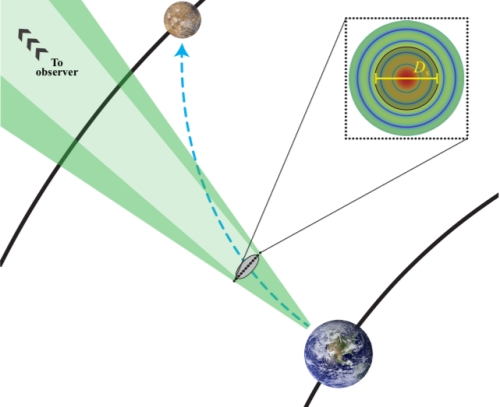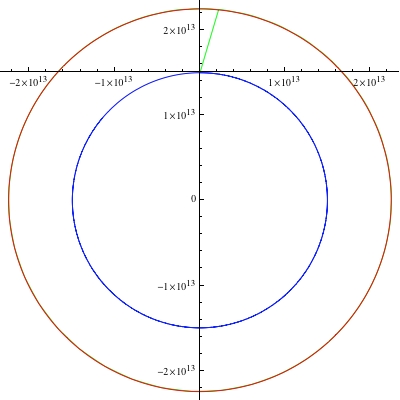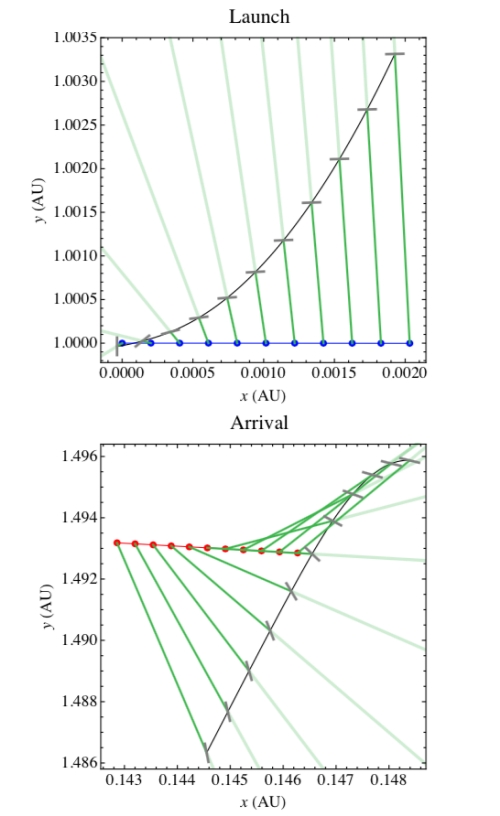We’ve long discussed intercepting not only beacons but stray radio traffic from other civilizations. The latter may be an all but impossible catch for our technology, but there is a third possibility: Perhaps we can intercept the ‘leakage’ from a beamed power infrastructure used to accelerate another civilization’s spacecraft. The idea has been recently quantified in the literature, and Jim Benford examines it here in light of a power-beaming infrastructure he has studied in detail on the interplanetary level. The CEO of Microwave Sciences, Benford is a frequent contributor to these pages and an always welcome voice on issues of SETI and its controversial cousin METI (Messaging to Extraterrestrial Intelligence).
by James Benford

Beaming of power to accelerate sails for a variety of missions has been a frequent topic on this site. It has long been pointed out that beaming of power for interplanetary commerce has many advantages. Beaming power for space transportation purposes can involve earth-to-space, space-to-earth, and space-to-space transfers using high-power microwave beams, millimeter-wave beams or lasers. The power levels are high and transient and could easily dwarf any of our previous leakage to space.
We should be mindful of the possibilities of increased leakage from Earth in the future, if we build large power beaming systems. It has been previously noted that such leakage from other civilizations might be an observable [1].
Now workers at Harvard have quantified the leakage from beaming for space propulsion, its observables and some implications for SETI. The paper is “SETI via Leakage From Light Sails in Exoplanetary Systems,” by James Guillochon and Abraham Loeb (http://arxiv.org/abs/1508.03043). Theirs is the first work to show quantitatively that beam-powered sailship leakage is an observable for SETI.
Studies have shown that leakage of TV and radio broadcast signals such as TV are essentially undetectable from one star to another. But the driving of sails by powerful beams of radiation is far more focused than isotropic communication signals, and of course far more powerful. Therefore they could be far more easily detected. These are not SETI signals so much as an easily detected aspect of advanced civilizations.
Fast track to Mars
The mission Guillochon and Loeb study is one that previous workers have quantified: interplanetary supply missions using unmanned spacecraft. The ship is a sail with payload, a sailship, propelled via microwave beam from Earth to Mars. Previous work was described here and in New Scientist (see New Sail Design to Reach 60 Kilometers Per Second in Centauri Dreams and “Solar super-sail could reach Mars in a month,” in New Scientist (29 January 2005).
The Mars mission is shown in figure 1: a beam-driven sailship transits from Earth to Mars. An interstellar observer sees the beam accelerating the sail because the beam overlaps the sail to some extent at all distances.

Figure 1. Schematic of Mars cargo mission via microwave beaming, not to scale. The path of the sailship is the dashed arrow. The inset is the beam profile shown in green overlaying the sail of diameter Ds. The beam always overlaps the sail to some extent.
The beam is accelerated from near Earth and is decelerated by a similar system near Mars. Parameters for the mission are based on my papers on Cost-Optimized SETI Beacons and Sailships [2,3]: 1-ton sailship accelerated to 100 km/sec, beam power 1.5 TW, power duration 3 hours, beam frequency 68 GHz, acceleration 1 gee, transmitter aperture 1.5 km, sail diameter 300 m, sail surface density 4 10-5 kg/m2. (For background, see A Path Forward for Beamed Sails and Detecting a ‘Funeral Pyre’ Beacon).
The calculation in the paper presumes the two planets are in conjunction for the voyage, the distance between the planets at this point is 0.5 AU, and the path, although shown bending in Fig. 1, is in fact almost a straight line between the two planets. Figure 2 shows the trajectory. This yields a 9 day transit time when traveling at 100km/s. Figure 3 shows the launch and arrival trajectories of the sailship.

Figure 2. Sail flight from Earth (blue orbit at 12 o’clock) to Mars(red orbit).

Figure 3. Top (bottom) panel shows sailship’s launch (arrival). Black curve shows sailship (gray segments, not to scale) leaving Earth (Mars), represented by the blue (red) curve. Blue (red) points represent Earth’s (Mars’) position at evenly spaced intervals. Green lines originating from the planets show beam direction.
The beam always overlaps the sail; that overlap will increase as the sail passes the limit for beam focusing with the given transmitter aperture. Beyond that distance the beam spot swells and the leakage rises as the sailship flies away, until the beam is turned off.
How to See Power Beams
At 100 parsecs (326 light years), beam intensity is estimated to be of order 1 Jansky, which is about 100 times the typical detectability of SETI radio searches. The sweeping action of the beam in Figure 2 has implications for observers. The receiving radio telescope will typically see a rising signal because the beam is beginning to sweep past, then a drop in signal as the sail’s shadow falls on the receiver, then a rise as the beam reappears, followed by a decline. In other words, the time varying history of intensity is a symmetric transient with two peaks with much less (or even nothing) in between. They estimate the timescale for the transit to be of order 10 seconds.
The transmitting and receiving systems will be used pretty constantly because they cost a lot to build, but launch expenses are low — basically the cost of the electrical energy. Because it is doing a transit from one planet to another, this gives an opportunity for us to use our growing knowledge of exoplanets in a clever way.
Because the rapidly accumulating information on exoplanets frequently produces all 6 elements needed to describe the orbits of the transiting planets, one can predict times when we will be in the line of sight of two planets which could be beaming power between each other to drive sailships. This ‘conjunction’ is a matter of our perspective; the two planets are not near each other, merely along our line of sight.
The Guillochon-Loeb paper quantifies this strategy for detecting such leakage transients. They estimate that if we monitor continuously, the probability of detection would be on the order of 1% per conjunction event. They state that “for a five-year survey with ~10 conjunctions per system, about 10 multiply-transiting, inhabited systems would need to be tracked to guarantee a detection” with our existing radio telescopes. Of course the key question is just which planets are inhabited, and that’s what SETI is trying to find out. The leakage would be evidence for that, so this statement is a bit circular.
The recently-announced Breakthrough Listen Initiative will have 25% of the observing time allocated on the Parkes and Green Bank telescopes, so could initiate such a search.
Consequences
This first-of-its-kind calculation shows that the forthcoming Breakthrough Listen Initiative has a new observable to look for. With enough observing time, the prospects for SETI seem to now be improved. If alien civilizations are using power beaming, as we ourselves will likely do in future centuries, we may observe the leakage of these more advanced societies.
Although not mentioned in the paper, there are two implications:
ETI, having done the same thinking, would realize that they could be observed. They could put a message on the power beam and broadcast it for our receipt at no additional energy or cost. So by observing leakage from power beams we may well find a message embedded on the beam. That message may use optimized power-efficient designs such as spread spectrum and energy minimization [4-5]. That would be more sophisticated than the simple 1 Hz tones looked for back in the 20th Century (see Is Energy a Key to Interstellar Communication?).
When we in future build large power beaming systems we will likely put messages on them. That is, if we’ve addressed the METI issue, meaning that we’ve had enough discussion and agreement by mankind of what we wish to say [6].
References
1. Gregory Benford, James Benford and Dominic Benford, “Searching for Cost Optimized Interstellar Beacons”, Astrobiology, 10, 491-498 (2010).
2. James Benford, Gregory Benford and Dominic Benford “Messaging With Cost Optimized Interstellar Beacons”, Astrobiology, 10, 475-490, (2010).
3. James Benford, “StarshIp Sails Propelled by Cost-Optimized Directed Energy”, JBIS, 66, 85-95, (2013).
4. David Messerschmitt, “Interstellar communication: The case for spread spectrum”, Acta Astronautica, 81, 227-238, (2012).
5. David Messerschmitt, “Design for minimum energy in interstellar communication”, Acta Astronautica, 107, 20-39, (2015).
6. John Billingham and James Benford, “Costs and Difficulties of large-scale METI, and the Need for International Debate on Potential Risks”, JBIS, 67, 17-23, (2014).



Observing these beams would require being within the ecliptic of the target system.
that’s already a requirement for observing transiting exoplanets anyway (which would be the only reason to look at particular system; no planets = no aliens likely).
An interesting post. This is far more plausible than expecting to find a beacon transmitting for our benefit. It does, however, still require a narrow coincidence in time between the aliens’ development of a spacefaring industrial society and our own.
Stephen
I’m not clear how this helps. The beams are going to be very few and far between (assuming they exist), with unknown peak wavelengths. This suggests that we need a 24/7 full sky survey at a large range of wavelengths to detect these transient signals. AFAICS, beaming is just another justification for search as it isn’t just altruistic/predatory information signaling.
The other issue is beam strength. The example given is for 100 pc distant. Is there likely to be a civ within that sphere (~ 70,000 bright stars)? Don’t we need to look much farther, and if so, will we be able to detect the beams? Does 1000 pc gets us to the limit of detection?
lastly, while beaming looks like a great technology from our early technology perspective, it may be quickly obsoleted by better approaches. In which case it might be the equivalent of looking for zeppelin signatures and missing all the civil airliners.
Alex,
The idea is to follow Dyson’s dictum “Search for what is observable, not what seems probable”. We’ll never know what to look for by assuming the (presently) unimaginable.
Alex Tolley, I agree with your assessment of this methods limitations but with so few methods to detect ETI activity, I think this is worth pursuing. After all we still use lighter than air vehicles.
James Benford, I take a cautious game theory approach to METI. If interstellar diplomacy can be considered a game, then there is a Nash Equilibrium. Imo, the most rational move for the more advanced player that sees all the playing field and players is to do nothing and for the less advanced player to keep looking and removing the ‘fog of war’ (reference to gaming not combat). While the risk of catastrophic impact from a shotgun in the dark METI approach is limited, I think there are still risks posed. Without knowing what the playing field looks like and who the other players are, we risk doing something that will prolong their silence and unwillingness to communicate. If we admit that the risk posed by not communicating are hypothetical, if not imaginary, then a cautious approach to METI is rational.
However, powering interplanetary missions with beamed power makes too much sense not to employ and will appear enough like METI that we can’t take a cautious approach. This may sound like a joke, but I would imbed a primer on how to play tic-tac-toe; a game that is played for the sake of playing and not for the sake of winning or losing.
A 1 Jy signal is quite strong. A 5 second scan of the signal gives
a signal to noise (SNR) of around 150 at 68 GHz with the Green Bank Telescope (GBT)
using the VEGAS back end in continuum mode. So if you want a SNR of at least 10, then it would be possible to observe such a signal to a distance to almost 400 pc.
The GBT is the only telescope at present which has a receiver that can pick up signals in this band (W1). Guillochon and Loeb are wrong to write that these observations could also be done at Parkes. Building such a receiver for Parkes is not enough, the whole antenna would have to be replaced as it is not sufficiently precise for radio waves of this frequency.
I am not sure there will be two peaks and nothing in between at least as seen from a very far distance. As the beam diverges and becomes much larger than the sail, which would occur well within the solar system, the chance of seeing a double peak would vanish to zero would it not as seen from another star at least. It would look more like a normal beam distribution with a smallish drop in light in the middle from diffraction and would have to be line of sight which would be very improbable.
I do like the idea of beam propulsions because of the mass/energy savings and it would tie in well with Brian and Alex’s spacecoach idea which would use water for propulsion. Microwave are absorbed very well by water and there is no need for a second beam at Mars for instance as you just use the energy in the beam from near Earth on your water store to decelerate you into orbit. I also liked the idea about using the beam as a communication/transmission carrier, neat idea.
I posted an earlier comment on this subject as soon as I saw the paper on the ArXiv website. I postulated that the TYC 1220-91-1 signal was a possible candidate. However this signal meets only a few(MOST STRIKINGLY, a 10 second duration) of the requirements for a strong candidate. The bandwidth was not “tens of gigahertz”, but instead, the “magic frequency” of(approximately)pi times hydrogen(well BELOW 10 gigahertz). Also, there was no INTERRUPTION of the signal. What I do NOT know, is whether there were any SUGNIFIGANT dips in the INTENSITY of the signal. If there were none, then TYC is not a candidate. If there WERE, then I would catagorise it as a WEAK candidate. Can any of you readers help me out here?
Can communications ride along a power beam?
When it comes to wondering why the galaxy seems so quiet in terms of technological civilizations, I refer to this as one possible motive and the reasons behind it:
http://www.projectrho.com/public_html/rocket/aliens.php#id–Alien_Contact–The_Fermi_Paradox–The_Killing_Star
Of course it could be wrong and the Milky Way is full of the equivalent of monks who have taken vows of silence, but how wise is it to walk into a jungle without knowing what might be in there first, or at least carrying a few hopefully useful means of protection with you.
I am assuming that 68 gigahertz(the EXAMPLE used in the paper) is OPTIMAL for a planet with an atmosphere extremely simalar to EARTH’S! What about an atmosphere only SLIGHTLY simalar to Earth’s would you need a DIFFERENT bandwidth to prevent absorbtion of the beam by the atmosphere, even if it requires MORE POWER? If so, not only could you prove the exixtance og ET, but you could ALSO CHARACTERIZE THE CHARACTER OF THE ATMOSPHERE OF ET’S HOME PLANET!
@Adam, Harold. I agree we should look, I just don’t see that this buys us anything beyond existing SETI searches in terms of making the search easier.
I always liked Dyson’s idea of looking for the observable, like frozen fish around Europa. But even simple experience tells you that looking for dead fish washed up on shore is much harder than taking a sample of seawater right in front of you and looking for bacteria or phytoplankton using a microscope/mass spec/DNA sequencer.
steven: “Can communications ride along a power beam?”
Yes, but there are a couple of major technical challenges. First, the power beam must be made sufficiently coherent to be useful as a carrier. Noise (phase, frequency, amplitude) on an (ideal) sine wave puts constraints on modulation type and data rate. Second, modulating a signal of extreme amplitude is non-trivial, especially since the active device generating the power is almost certainly an oscillator rather than a final amplifier stage. This is equally the case for radio/microwave and laser.
These are technical challenges, not theoretical. So it could be done with suitable advances in technology.
Alex, If our ability to detect ETL and/or ETI were a Swiss army, then I agree this method amounts to another flimsy plastic tooth pick. But experience tells us MacGyver!
ljk,
I think ‘do unto others before they do unto you’ would be the strategy least likely to be successful over the long term and the most difficult to apply. As a planetary civilization develops the tools needed to destroy other planetary civilizations it is simultaneously developing the tools needed to produce other planetary civilizations. If an ETI has emerged previous to humanity and has spread through the galaxy, that ETI has experienced at least some degree of cultural and ‘genetic’ speciation. Any individual civilization that practiced a shoot first strategy would pose a huge risk to the other civilizations. Planets are certainly vulnerable to assault, but I think, as a survival strategy, that vulnerability would manifest as something similar to mutually assured destruction. Only the first civilization would be able to employ the shoot first strategy and only at the cost of remaining bound to there own solar system or by maintaining strict homogeneity.
Exaggerated theories to explain the ‘Great Silence’ such as ETIs being monks or paranoid sociopaths is only necessary if we exaggerate our ability to measure the volume of the ‘Great Silence.’
“First, the power beam must be made sufficiently coherent to be useful as a carrier.”
Realistically, that’s a requirement for long range power beaming anyway. The modulation is the issue. Modulating the beam increases the difficulty of generating it in the first place, especially if you used frequency modulation.
Why not multiple beams each working towards the signal generation with a main beam for propulsion? And the information need not be to communicate with an alien civ but just to transmit information for the crew i.e. what’s going on? family albums, fan mail, packaged data etc.
Brett: ““First, the power beam must be made sufficiently coherent to be useful as a carrier.”
Realistically, that’s a requirement for long range power beaming anyway.”
No, not really. Even white noise can be suitable for power beaming. All you need is an antenna with a narrow beamwidth. For example, an incandescent bulb with a 1,000 meter diameter parabolic mirror. It’s just that lasers can do both coherence and beaming. Of course the term “coherence” is often used as including both attributes, in which case you have somewhat of a point.
Harold said on September 27, 2015 at 10:06:
“I think ‘do unto others before they do unto you’ would be the strategy least likely to be successful over the long term and the most difficult to apply.”
Not if you are a sentinel machine.
I do not want this to be right, and I hope the behavior of life on this planet is the exception and not the rule, but I get the feeling that biological creatures evolving in environments similar to ours will develop in a similar fashion as life on Earth did. Which means the ones who are just smart and aggressive enough – along with having the most numbers – win out.
Humans collectively are just barely smart enough not to exterminate themselves, and most of that is due to self-interest and preservation. Will we last long enough to colonize the stars? Have other intelligences gone through the same things? That is why I want to see SETI ramped up.
Alex Tolley:
Then again, a simple walk on the beach shows that every inch of the waterline is full of proofs of life much easier to detect than invisibly small bacteria in a sample of seawater. Not fish, so much, but seashells, crab parts, seeweed, etc. Also, bottle fragments and plastic artifacts indicative of intelligent life (sort of).
In addition, note that DNA based detection methods most likely won’t work, and mass-spec will provide lots of tentative, but few conclusive results. Microscopy, though, should work well.
@Eniac – while kelp is common on California shores, this is not always the case. Some beaches require walking to find dead crustacea or echinoids. Rocky shores require clambering to find that rock pool full of macro fauna.
This translates to locating a beach, getting to it, then moving along its surface to find evidence of life. fail in any of these endeavors and you find nothing.
In contrast, just leave some sterile broth open to the air and you will find it replete with bacteria and funfi within a few days with no effort.
Translate this to looking for life on an icy world. A plume of sub-surface ocean water conveniently reaching an orbital height can be sampled for life – even if that may be a little difficult. Conversely, locating the origin of the plume, landing nearby and then using a rover to find the edge to look for stranded macrolife is going to be a lot more involved. If you happen to see a “fish”, that is fantastic, but also unlikely, and there are plenty of failure modes before you even get the chance.
Interestingly the discovery of liquid brines on Mars may make life discovery harder as landers may be prevented from going to those sites for planetary protection reasons.
Alex: You must have very clean beaches in California. Here at Revere Beach, there are plenty (and unappetizing) examples of (ex-)life literally every inch along the beach, at least during low tide. No need for searching… :-)
The sterile broth experiment is quite a bit more difficult when the organisms to be cultured are alien. We have to make many guesses about what a good growth medium is, and even about the right physical conditions. And, obviously, only pure autotrophs can be detected, as our “broth” cannot contain alien biological materials the existence of which is yet to be established.